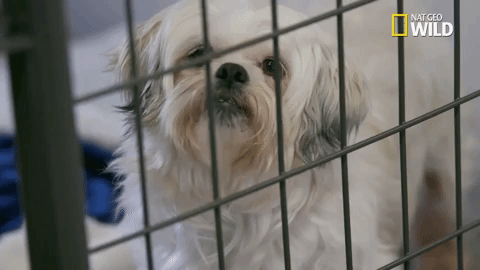CBD or Cannabidiol is the main component of the cannabis plant.
Cannabinoids interact with receptors in the central nervous system, ease anxiety, and promote sleep. CBD oil has the advantage of not being psychoactive (so it does not have addiction liability). It has a wide range of benefits in the veterinary field, including beneficial effects in the canines suffering from CNS disorders like anxiety, depression, and panic disorders. It can act as an analgesic for dogs suffering from painful disorders and has been used to calm many an anxious dog. Dr. Klein said, “We are likely to see continued interest in CBD and an increase in research about its uses and efficacy in the coming years.”
Symptoms of Anxiety in Dogs
Anxiety in dogs includes a wide range of symptoms. If some of these symptoms are present in your dog, it may suggest that your dog is suffering from anxiety.
- Whining or barking
- Cowering
- Clingy behavior
- Increase in awareness
- Panting
- Yawning
- Unexpected defecation or urination
- Trying to break objects like toys, furniture, etc.
- Hiding under furniture or wherever possible
- Lip licking
- Flattening ears and shrinking away
- Compulsive behavior (sometimes to the point of self-harm)
- Shaking or Trembling
- Pacing back and forth
- Drooling
- Vomiting
- Trying to run away
- Aggressive behavior
“Those subtle body language signs can signal more mild signs of anxiety,” Dr. Mornement says. He also added, “They are important because they are precursors to deeper anxiety and if you pick up on them and act, it’s less likely to escalate.”
Causes of Anxiety:
Anxiety in dogs has different causes, similar to humans. Some of the common causes of anxiety in dogs are divided into the following categories:
Behavioral:
The most common behavioral cause is separation anxiety, which includes destructive and disruptive behavior of dogs in the absence of their guardians. This behavior is an indication of separation anxiety. The intensity of anxiety increases when dogs are separated from the people they are attached to. Extreme separation anxiety may result in household or self-injury. They may try to escape from exit points like doors and windows, harming themselves. Typically, after you leave your canine friend, it will start displaying distress behaviors like barking moments after you have left your dog alone. Your dog may also try to stop you from leaving the house.
“Dogs [often] associate everything they value in their life such as company, play, food, going for walks — with when people are around,” Dr. Mornement says
Situational:
Situational causes of anxiety include fireworks and thunderstorms. Pets are at risk of getting freaky, anxious, and terrified by thunderstorms or fireworks. Dogs are vulnerable to high pitched sounds and flashing lights. According to data by American pet society’s annual survey report, about 65 percent of domesticated pet species get scared due to fireworks. Fireworks contain potassium nitrate; continuous exposure results in stress, anxiety, and mental disturbance. Thunderstorms and firecrackers trigger flight or fight response due to flashing lights and sounds, which gives rise to restlessness.
“Dogs are naturally fearful of those events because they are loud and scary, so they learn to associate the [lower level] noise of wind or rain with those events,” Dr. Mornement says.

CBD Oil for Anxiety and Anxiety-related Disorders:
Stress due to any cause can impact the life quality of canines. CBD has shown a lot of benefits in dogs suffering from anxiety and fear. Like humans, animals have an endocannabinoid system that controls all body systems, particularly the nervous system and immune system. As ThePets resource notes CBD binds to the endocannabinoid receptors present in the nervous system, promoting various physiological processes, such as appetite, metabolism, sleep, pain, and mood.
Expert veterinarian Amatucci said:
“We have found that many pet owners that use CBD for their cats and dogs really love it and say it works for tackling problem behavior or just giving their pet a better sense of overall calm,”
1. Calm Nervous System
By acting on the endocannabinoid system, CBD can promote calming effects on the nervous system of dogs. This guide shows that the effects of CBD can be enhanced when used in combination with other sedative therapies. When the stress or anxious feelings are suppressed, dogs would feel healthier both mentally and physically.
2. Reduces effects of inflammation
In many dogs, anxiety may be caused by trauma or a defective immune system due to several conditions such as neuropathic pain, inflammation, arthritis, and skin irritation. CBD can lower the effects of inflammation and eases the pain that works as anti-anxiety in dogs.
3. Reduces the metabolic breakdown
CBD reduces the metabolic breakdown of endocannabinoids that are naturally produced by the dog’s body. Endocannabinoids are responsible for regulating the pain pathway. CBD slows down their breakdown, causing an increase in endocannabinoids in canines at CB receptors resulting in decreased neuropathic pain.
4. Effective in the treatment of arthritis
If your dog is suffering from chronic pain caused by arthritis, you must have heard of CBD as a treatment from someone. CBD, along with THC and other chemicals, is present in cannabis. But CBD is not addictive like other cannabis compounds. Arthritis affects the joints of senior dogs, which usually causes severe pain and stiffness.
Dogs suffering from arthritis require treatment that acts as an anti-inflammatory to decrease stiffness and analgesic to treat arthritis pain. CBD, in combination with other anti-inflammatory or analgesics, is useful in the treatment of arthritis. CBD acts to reduce pro-inflammatory cytokines, stop leukocytes proliferation, and prevent immune cells’ adhesion and migration.
Duration of Action of CBD:
CBD oil has a wide range of duration of action. How much time it will take to show a significant effect on your dog depends on your dog’s condition and the dosage and brand of CBD product according to sources. For chronic pain or inflammatory disorders, it may take a few weeks to show significant results. However, for anxiety or depressive symptoms, you may start to notice changes in your dog’s behavior within an hour.
Precautions Regarding CBD Oil:
Dosage:

Experts and vets encourage taking proper cautions and measures while giving CBD to your dogs because of the lack of studies and trials on its usage and safety. Many vets prescribe CBD as the best treatment for dogs with anxiety, PTSD, and many other nervous disorders. The following measures should be taken while giving CBD to dogs:
- Consult with the vet before starting any treatment for your dog.
- Use high-quality CBD products that do not contain hazardous compounds or toxins.
- Start with the minimum dose (about 0.25 mg per day), and then gradually increase the amount, if necessary. Monitor the response of your dog to any given medication.
- Assess any underlying illness, especially kidney or liver disease, which may affect the dog’s body’s metabolism or reaction to CBD.
- Determine your dog’s size, weight, and physical activity that can give you information about how your dog will metabolize CBD or other drugs.
- Check out the required potency for your dog and buy accordingly. CBD oils are available in different CBD potencies. The optimum power of CBD oil for large dogs is 300 mg and above. However, for small dogs, it is 75mg.
Possible Side Effects Related to Overdose of CBD in Dogs:
If you give an optimum dose of CBD to your dog, it typically shows no side effects. However, in case of overdose following effects may be seen:
- Dry mouth
- Lethargy
- Vomiting
- Increased sensitivity to the senses
- Urinary incontinence
- Lowered blood pressure
- Impaired balance or coordination
- Drowsiness
Photo credits jcomp – www.feepik.com
Did you enjoy this article? Dog lovers might find these interesting, as well:
Dog Games: 10 Fun Ways to Learn & Bond for Puppy and Child
Do You Know How to Identify Dog Seizure Symptoms?
The Extraordinary Soul Connection I Call The Human Animal BodyMind Connection
The post CBD Oil for Anxiety: Can it Calm your Anxious Dog? appeared first on Val Heart.
source https://valheart.com/cbd-oil-for-anxiety-can-it-calm-your-anxious-dog/





 Is there a Real Dr. Doolittle? Yes, there is. Welcome to our Show on Talking to the Animals
Is there a Real Dr. Doolittle? Yes, there is. Welcome to our Show on Talking to the Animals














